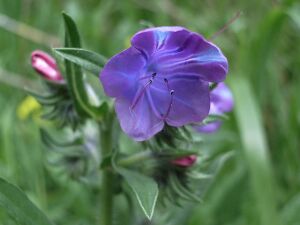Patterson’s Curse: Difference between revisions
imported>Aleta Curry (new stub - April write-a-thon) |
mNo edit summary |
||
| (8 intermediate revisions by 2 users not shown) | |||
| Line 1: | Line 1: | ||
{{subpages}} | {{subpages}} | ||
Echium plantagineum is a hardy, fast-growing flowering plant known to millions of Australians as Patterson’s Curse or sometimes Paterson’s Curse. Alternate names include Salvation Jane and Riverina Bluebell. Introduced for the loveliness of its bluish-purple [[flower]]s, it quickly took hold in the hospitable Australian climate. Patterson’s Curse has now become naturalised, and is classed as a [[noxious weed]] over most of the continent. “The weeds numbers and distribution must be reduced annually. | {{Image|Patterson's curse.jpg|right|300px|The bluish-purple flower of Patterson’s Curse}} | ||
Sale, propagation and wilful distribution of Paterson’s Curse is an offence.” <ref> http://www.greatlakes.local-e.nsw.gov.au/files/10959/File/Pattersons-Curse-Class-4-management-plan.pdf</ref> <! | '''''Echium plantagineum''''' is a hardy, fast-growing flowering plant known to millions of Australians as '''Patterson’s Curse''' or sometimes '''Paterson’s Curse'''. Alternate names include '''Salvation Jane''' and '''Riverina Bluebell'''. Introduced for the loveliness of its bluish-purple [[flower]]s, it quickly took hold in the hospitable Australian climate. Patterson’s Curse has now become naturalised, and is classed as a [[noxious weed]] over most of the continent. “The weeds numbers and distribution must be reduced annually. | ||
Sale, propagation and wilful distribution of Paterson’s Curse is an offence.” <ref>Patterson's Curse Class-4 management plan ([http://www.greatlakes.local-e.nsw.gov.au/files/10959/File/Pattersons-Curse-Class-4-management-plan.pdf pdf])</ref> <!--Is this in some jurisdictions only or all over Australia?--> Patterson’s curse should be sprayed at rosette stage or before flowering for effective control. | |||
Patterson’s Curse is bad for [[horse]]s and other livestock and can cause [[liver]] failure. Animals can be poisoned from eating the weed directly or remnants of it in cut hay. Fortunately, the plant is not very palatable and horses tend to eat it only when they have no other feed. <ref> | Patterson’s Curse is bad for [[horse]]s and other livestock and can cause [[liver]] failure. Animals can be poisoned from eating the weed directly or remnants of it in cut hay. Fortunately, the plant is not very palatable and horses tend to eat it only when they have no other feed. <ref>[http://www.aspca.org/site/PageServer?pagename=pro_apcc_horsetoxic_pattersonscurse Animal Poison Control Center] hosted by ASPCA. Sourced December 2, 2007.</ref> | ||
==References== | |||
<references/>[[Category:Suggestion Bot Tag]] | |||
Latest revision as of 06:00, 2 October 2024
Echium plantagineum is a hardy, fast-growing flowering plant known to millions of Australians as Patterson’s Curse or sometimes Paterson’s Curse. Alternate names include Salvation Jane and Riverina Bluebell. Introduced for the loveliness of its bluish-purple flowers, it quickly took hold in the hospitable Australian climate. Patterson’s Curse has now become naturalised, and is classed as a noxious weed over most of the continent. “The weeds numbers and distribution must be reduced annually. Sale, propagation and wilful distribution of Paterson’s Curse is an offence.” [1] Patterson’s curse should be sprayed at rosette stage or before flowering for effective control.
Patterson’s Curse is bad for horses and other livestock and can cause liver failure. Animals can be poisoned from eating the weed directly or remnants of it in cut hay. Fortunately, the plant is not very palatable and horses tend to eat it only when they have no other feed. [2]
References
- ↑ Patterson's Curse Class-4 management plan (pdf)
- ↑ Animal Poison Control Center hosted by ASPCA. Sourced December 2, 2007.
